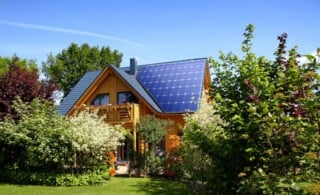
It’s easy to take trees for granted, but trees add essential elements that humans and animals need to live. Not only do humans get oxygen and food from trees, but trees also play an important role as providers of wood, shelter, shade, aesthetic beauty, and ecological contributions such as climate amelioration, water conservation, and soil preservation. Planting a tree can be a simple process but one that will have far-reaching benefits for society as a whole.
Facts and Figures on Forests
Forests cover land all over Earth in varying degrees. Some of the most forest-rich countries include Brazil, Canada, the United States, China, and Australia. It’s estimated that forests cover about 30 percent of Earth’s total land area, and of this acreage, more than one-third of the forests are considered primary forests. Primary forests have no clear evidence of human activity or significant disturbance. Scientists estimate that Earth’s forests store 283 gigatons of carbon, accounting for 50% more carbon than the amount found in our atmosphere.
- U.S. Forests Facts and Historical Trends (PDF): The percentage of forest land in the United States has been mostly stable for more than 100 years.
- Facts About Wood (PDF): About two-thirds of the forest area that covers the United States is sufficiently productive to grow trees used for commercial purposes.
- Our World in Data: Forests: Human settlement has historically involved deforestation over time. However, some countries are successfully reversing this trend.
- The State of the World’s Forests: As the population grows, the need for food will increase along with it. Although deforestation may seem necessary to convert land to agricultural use, this change can lead to other negative impacts on the environment.
How to Plant a Tree
The best time to plant a tree is during the dormant season in temperate zones and during the rainy season in tropical and subtropical regions. Preparing the planting site correctly, placing the tree into the ground carefully, and caring for the tree diligently after planting are all important factors that will help a newly planted tree grow and thrive.
Step 1
The first step in planting a tree is to dig a hole that is at least two to three times wider than the root ball, which allows the roots to spread. Make the hole deep enough so that when you place the tree in the hole, the root collar sits just above or level with the top of the hole.
Step 2
Loosen the root ball gently before you place it into the prepared hole, and situate the tree in the hole so it’s straight. Consider using a pole to support it while it grows.
Step 3
Fill the hole with soil and pat it firmly to finish planting.
Step 4
Water the newly planted tree, but don’t fertilize it. Keep the tree adequately watered for the first few months, and remove any weeds that grow around the tree.
Step 5 – Optional
If see a lot of herbivore paw prints in your neighborhood, consider adding a circle of fencing around the plant to protect it while it matures.
- How to Plant Containerized Trees: Trees purchased in pots or containers are ready to plant in the ground.
- Planting Trees Correctly: The first step to planting a tree correctly is to choose a tree that will grow successfully in a particular area.
- The Well-Planted Tree (PDF): Accidentally planting a tree too deep is a common mistake, and this can lead to premature death of the tree.
- Tree and Shrub Planting Guidelines: Most trees prefer to receive at least six to eight hours of direct sun each day.
- The Science of Planting Trees: Proper site preparation is key to making sure that a tree grows well.
- Planting Landscape Trees and Shrubs (PDF): Choose a tree or shrub based on its mature size and the location.
Trees and Humanity
Not only are trees helpful to the environment, but they also provide a variety of other benefits. Trees are sources of wood, medicine, fruit, and beverages. Trees also provide a number of services, such as erosion control, soil enhancement, shade, and beauty. Forests provide recreational opportunities, too: People often enjoy spending time in and around forests because they are peaceful and beautiful areas.
- Top 22 Benefits of Trees: Trees absorb carbon dioxide and release oxygen back into the environment.
- Benefits of Trees: Just having trees around helps soothe and relax people, and it’s easier to connect with nature with trees nearby.
- How Trees Make a Difference: Tree leaves can absorb pollution, helping to filter out contaminants in the air.
- Trees Sustain Life on Earth: The World Bank estimates that 60 million people are fully dependent on forests for their livelihoods.
- Trees and Your Environment: Carbon dioxide is a major contributor to the greenhouse effect, and trees can help absorb carbon dioxide from the air.
Also Check Out These Educational Sources:
- Tree Conservation: Conserving trees is important to ensure the continued quality of the environment.
- Global Tree Conservation: Conserving trees globally is crucial because more than 10 percent of the world’s tree species are threatened with extinction.
- When to Cut Down a Tree: There are times when it’s necessary to cut down a tree, but sometimes, a tree might look like it’s dead when it’s really just dormant.
- Planting a Tree: Choose a tree and the best time to plant it when you want to make an investment for the planet.
- Lawn Care and Gardening Pros
- The Proper Way to Plant a Tree (video): Watch this video to learn exactly how to plant a tree.
- How to Plant a Tree the Right Way: Take the time to properly prepare a planting site for a new tree to ensure that the tree thrives for many years.
 Sustainable Home Improvements that Help Save the Planet
Sustainable Home Improvements that Help Save the Planet  Green Building Glossary
Green Building Glossary  Green Kitchens
Green Kitchens  “Green” Interior & Exterior Windows
“Green” Interior & Exterior Windows  Choosing Green: Boilers and Radiator Heating Systems
Choosing Green: Boilers and Radiator Heating Systems 

Are You Familiar With This Topic? Share Your Experience.